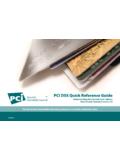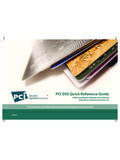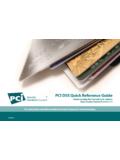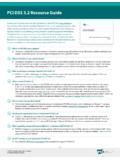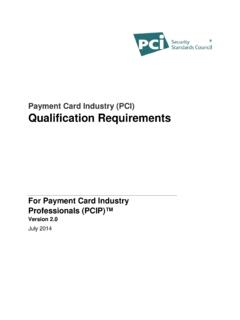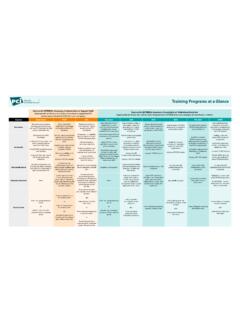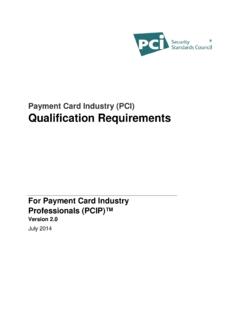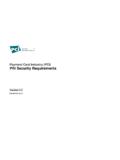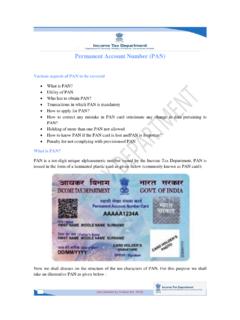Transcription of PCI DSS Information Supplement Tokenization
1 Information Supplement : PCI DSS Tokenization Guidelines Standard: PCI Data Security Standard (PCI DSS) Version: Date: August 2011 Author: Scoping SIG, Tokenization Taskforce PCI Security Standards Council 2 Information Supplement PCI DSS Tokenization Guidelines August 2011 The intent of this document is to provide supplemental Information . Information provided here does not replace or supersede requirements in the PCI Data Security Standard. Table of Contents 1 Executive Summary .. 3 Objective .. 3 Intended 3 Introduction to Tokenization .
2 3 2 Tokenization Overview .. 5 Tokenization System Common Components .. 6 Token Generation .. 6 Token Mapping .. 7 Card Data Vault .. 7 Cryptographic Key Management .. 7 Tokenization Operations .. 8 Tokenization Security Considerations .. 10 Network Segmentation .. 10 Authentication .. 10 Monitoring .. 11 Token Distinguishability .. 11 PCI DSS Requirements .. 12 Tokenization Roles and Responsibilities .. 12 Tokenization Deployment Models .. 12 Merchant Responsibilities .. 14 TSP Responsibilities .. 15 3 PCI DSS Scoping Considerations.
3 17 PCI DSS Scope for Tokenization .. 17 Scoping Principles .. 17 Out-of-Scope Considerations .. 18 Maximizing PCI DSS Scope 18 4 Additional Considerations .. 20 Tokens as Payment Instruments .. 20 Understanding the Risks .. 20 5 Conclusion .. 21 6 Acknowledgments .. 22 7 About the PCI Security Standards Council .. 23 3 Information Supplement PCI DSS Tokenization Guidelines August 2011 The intent of this document is to provide supplemental Information . Information provided here does not replace or supersede requirements in the PCI Data Security Standard.
4 1 Executive Summary Objective The purpose of this Information Supplement is to provide guidance for payment industry stakeholders when developing, evaluating, or implementing a Tokenization solution, including how Tokenization may impact Payment Card Industry Data Security Standard (PCI DSS) scope. This document provides supplemental guidance on the use of Tokenization and does not replace or supersede PCI DSS requirements. This document does not define the technical specifications or steps required to implement a Tokenization solution, nor does it describe how to validate PCI DSS compliance for environments using Tokenization .
5 This document is not an endorsement for any specific technologies, products or services. Intended Audience This Information Supplement is intended for merchants that store, process, or transmit cardholder data and are seeking guidance on how implementing a Tokenization solution may impact the scope of their compliance efforts with the (PCI DSS). Other payment industry stakeholders including payment processors, acquirers, service providers, assessors, and solution vendors may also find the Information in this document useful. Introduction to Tokenization Tokenization is a process by which the primary account number (PAN) is replaced with a surrogate value called a token.
6 De- Tokenization is the reverse process of redeeming a token for its associated PAN value. The security of an individual token relies predominantly on the infeasibility of determining the original PAN knowing only the surrogate value. Depending on the particular implementation of a Tokenization solution, tokens used within merchant systems and applications may not need the same level of security protection associated with the use of PAN. Storing tokens instead of PANs is one alternative that can help to reduce the amount of cardholder data in the environment, potentially reducing the merchant s effort to implement PCI DSS requirements.
7 The following key principles relate to the use of Tokenization and its relationship to PCI DSS: Tokenization solutions do not eliminate the need to maintain and validate PCI DSS compliance, but they may simplify a merchant s validation efforts by reducing the number of system components for which PCI DSS requirements apply. Verifying the effectiveness of a Tokenization implementation is necessary and includes confirming that PAN is not retrievable from any system component removed from the scope of PCI DSS. 4 Information Supplement PCI DSS Tokenization Guidelines August 2011 The intent of this document is to provide supplemental Information .
8 Information provided here does not replace or supersede requirements in the PCI Data Security Standard. Tokenization systems and processes must be protected with strong security controls and monitoring to ensure the continued effectiveness of those controls. Tokenization solutions can vary greatly across different implementations, including differences in deployment models, Tokenization and de- Tokenization methods, technologies, and processes. Merchants considering the use of Tokenization should perform a thorough evaluation and risk analysis to identify and document the unique characteristics of their particular implementation, including all interactions with payment card data and the particular Tokenization systems and processes.
9 5 Information Supplement PCI DSS Tokenization Guidelines August 2011 The intent of this document is to provide supplemental Information . Information provided here does not replace or supersede requirements in the PCI Data Security Standard. 2 Tokenization Overview One of the primary goals of a Tokenization solution should be to replace sensitive PAN values with non-sensitive token values. For a token to be considered non-sensitive, and thus not require any security or protection, the token must have no value to an attacker. Tokens come in many sizes and formats.
10 Examples of some common token formats are included in the following table. Table 1: Selected Examples of Token Formats* PAN Token Comment 3124 005917 23387 7aF1Zx118523mw4cwl5x2 Token consists of alphabetic and numeric characters 4959 0059 0172 3389 729129118523184663129 Token consists of numeric characters only 5994 0059 0172 3383 599400x18523mw4cw3383 Token consists of truncated PAN (first 6, last 4 of PAN are retained) with alphabetic and numeric characters replacing middle digits. * Note: This table provides a selection of examples only, and does not include all possible token formats.
